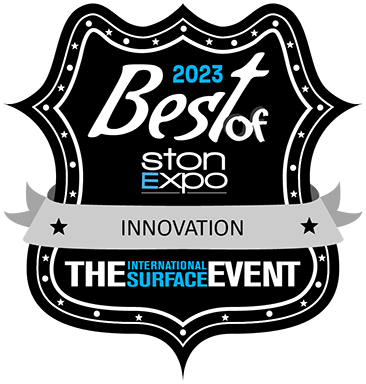GuidesStone Care Guides
How to Clean Mildew off Concrete Patio
Mildew on concrete patios can pose several challenges, from unsightly stains to potential health risks. Concrete, while not a food source for mildew, can support its growth if consistently moist, dirty, and shaded.
It's crucial to remove mildew promptly to prevent staining, corrosion, and the spread of mildew to other areas, including the interior of your home.
Effective removal not only improves the appearance of your patio but also safeguards the health of those with allergies and maintains the structural integrity of your outdoor space.
What is Mildew?
Mildew is a type of fungus that appears as a thin, black or white growth on surfaces. It thrives in damp environments and can spread rapidly under the right conditions. Unlike mold, which can penetrate and damage materials, mildew tends to grow on the surface, making it easier to remove but still problematic.
Preparation for Cleaning Mildew from Concrete
Protective Gear
When preparing to clean mildew off your concrete patio, it's essential to prioritize safety. Wear appropriate protective gear, including gloves to protect your hands from harsh chemicals, goggles to shield your eyes from splashes, and a respirator or mask to prevent inhalation of mildew spores and chemical fumes.
Proper Ventilation
Ensure that the area is well-ventilated. Good airflow helps disperse any harmful fumes from cleaning solutions and reduces the concentration of mildew spores in the air, making the cleaning process safer.
Brief Inspection
Before starting the cleaning process, assess the extent of the mildew infestation. Small infestations (less than 10 square feet) can typically be handled with manual cleaning methods. Large infestations, however, might require professional intervention to ensure complete and safe removal.
Cleaning Mildew from Concrete Patios

For manual cleaning, gather the necessary tools such as a stiff brush and scrubbers. These will help you physically remove the mildew from the concrete surface.
Use a dedicated outdoor cleaning solution like MB Stone® BSC Hardscape. This outdoor cleaner can be used safely on concrete surfaces to remove mildew. Simply spray it on the affected area and scrub with a brush. Wash away after a few minutes.
This cleaner can be used safely without the hassle of renting or using a power washer. Just apply it, let it work its magic, and enjoy your clean outdoor space. Perfect for those in high-rise apartments or rentals where power washing is not feasible!
To keep mildew at bay, Hardscape BSC can also be used for residual effects. After initial cleaning, spray the patio surface with Hardscape BSC and leave it wet. This allows the cleaner to continue working for up to a month, preventing new mildew growth and greatly simplifying future cleanings.
When to Use Pressure Washers
A pressure washer is ideal for larger or more stubborn mildew infestations in open areas. It uses high-pressure water to remove mildew effectively and efficiently.
Steps for Pressure Washing
- Set Up the Pressure Washer: Follow the manufacturer's instructions to set up the pressure washer, ensuring all connections are secure.
- Usage: Always point the pressure washer away from people and delicate objects. Start with a low-pressure setting to avoid damaging the concrete surface and gradually increase the pressure as needed.
Addressing Larger Mildew Infestations
Identifying Large Infestations (>10 sq ft)
If you identify a mildew infestation larger than 10 square feet, it is considered significant and may require professional assistance. Large infestations can be challenging to manage with DIY methods alone.
When to Call a Professional
Calling a professional is advisable for extensive mildew issues. Professionals have the expertise and equipment to handle large infestations effectively and safely.
Cost Considerations
The cost of professional removal can vary, typically ranging from $150 to $400 depending on the extent of the infestation and the services required. While this might seem costly, professional removal ensures thorough cleaning.
Post-Cleaning Steps
Inspect the Cleaned Area
After cleaning, inspect the area to ensure all mildew has been removed. Look for any remaining spots and address them promptly.
Address Underlying Moisture Issues
Identify and fix any underlying moisture issues that contributed to the mildew growth. This could involve repairing leaks, improving drainage, or increasing ventilation.
Causes of Mildew Growth on Concrete
Moisture Accumulation
Mildew growth on concrete is primarily driven by moisture accumulation. Concrete patios, especially those that are not properly sealed, can absorb water from rain, humidity, or nearby plants. This persistent moisture creates an ideal breeding ground for mildew, which seeks out damp conditions to thrive.
Lack of Sunlight
A concrete patio shaded by overhanging branches or structures can also become a hotspot for mildew. Mildew prefers cool, shaded environments where sunlight cannot reach to dry out the moisture. This lack of direct sunlight prevents the natural evaporation of water, maintaining a consistently damp surface that encourages mildew growth.
Poor Ventilation
Poor ventilation further exacerbates the problem. Enclosed or partially enclosed patios, or those with limited airflow due to surrounding walls or dense foliage, can trap moisture and create stagnant air conditions. This lack of ventilation prevents the drying of concrete surfaces, thus fostering an environment where mildew can flourish.
Risks Posed by Mildew on Concrete
Allergic Reactions
Mildew on concrete patios can pose significant health risks, particularly for individuals with allergies. Exposure to mildew spores can trigger allergic reactions, causing symptoms such as sneezing, runny nose, red eyes, and skin rashes. For those with existing allergies, contact with mildew can exacerbate these symptoms, leading to increased discomfort and health issues.
Respiratory Issues
Beyond allergic reactions, mildew can also cause respiratory problems. Inhalation of mildew spores can irritate the respiratory tract, leading to coughing, wheezing, and shortness of breath.
People with asthma or other pre-existing respiratory conditions are particularly vulnerable, as mildew exposure can aggravate their conditions and potentially lead to more severe health complications.
Concrete Staining
Mildew can also have a detrimental impact on the appearance of your concrete patio. One of the most immediate effects is staining. Mildew leaves unsightly black or green marks on the surface of the concrete, diminishing the aesthetic appeal of your outdoor space. These stains can be stubborn and difficult to remove, requiring thorough cleaning and maintenance to restore the patio's appearance.
Concrete Surface Deterioration
In addition to staining, mildew can contribute to the deterioration of the concrete surface. While concrete itself is not a food source for mildew, the presence of mildew can indicate underlying moisture problems. Persistent moisture can lead to the weakening and erosion of the concrete over time. This surface deterioration not only compromises the structural integrity of the patio but can also lead to costly repairs if left unaddressed.
How to Prevent Mildew Growth on Concrete Patios
Reduce Shade and Moisture
To reduce the likelihood of mildew growth, prune any overhanging branches that cast excessive shade on your concrete patio. Allowing more sunlight to reach the surface helps keep it dry and less hospitable to mildew.
Improve Drainage
Improving the drainage around your patio is crucial. Ensure that water does not pool on the concrete surface by addressing any drainage or grading issues. Properly installed gutters and downspouts can help redirect water away from the patio area.
Increase Ventilation
If your patio is enclosed or partially enclosed, increasing ventilation is key. Installing vents can help promote airflow, which reduces moisture accumulation and discourages mildew growth. Make sure these vents are positioned to maximize airflow throughout the area.
Keep the Patio Clean and Dry
Regular maintenance is essential in preventing mildew. Keep your patio clean by sweeping away debris and dirt that can retain moisture. After cleaning, ensure the patio is dry, as standing water promotes mildew growth.
Seal the Concrete Surface
Applying a concrete sealant can provide an additional layer of protection against moisture. Sealed concrete is less porous, making it more resistant to mildew.


